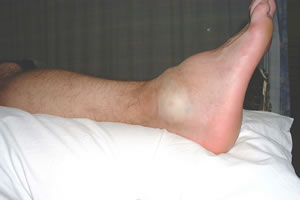Inflammation
Inflammation is the protective response of the bodies tissues to injury or irritation. It is a condition of an area of skin or any other tissue that has become sore, swolllen, reddened due to infection or injury. Inflammation may be acute or chronic in nature.
Acute inflammation occurs straight away after an injury. Inflammation is classified as chronic if it persists after 2-4 weeks.
|  |
Redness: The redness is caused by an increase in blood flow due to vasodilation of small blood vessels within the damaged area.
Swelling: An increase in vascular permeability is responsible for swelling. This results in oedema, which is the accumulation of fluid in the extra vascular space as part of the fluid exudate.
Heat: Caused by increased blood flow (hyperaemia) through the region due to vasodilation.
Pain: Due to the stretching and distortion of tissues due to inflammatory oedema. Pain is a direct stimulus response from nerve endings.
Loss of Function: Depends on the site and extent of the injury. Limited range of movement can be caused by swelling, and inhibition of muscular contraction is caused by pain.